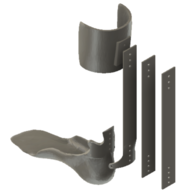3D Printed Ankle Foot Orthosis with Modular Strut Configuration and Reconfigurable Stiffness
TECHNOLOGY NUMBER: 2019-154

OVERVIEW
3D-printed ankle foot orthosis (APO) with a pre-bent steel strut and tunable stiffness- Minimizes AFO-shoe interference by diminishing the need for thick reinforcement of the foot
- Permits variable rehabilitation options by adding or subtracting steel plates to the base strut
BACKGROUND
An ankle foot orthosis (AFO) is a device that encompasses the leg and foot to improve walking patterns caused by any of variety of physical illnesses. The general types of conditions which may lead a patient to require an APO include pain, limited range of motion, muscle weakness or paralysis, neurological deficits such as those caused by cerebrovascular accident, sensory deficit, or asymmetric leg length. An APO is worn with socks and shoes and can reduce, prevent, or limit maladaptive movement of the lower leg and foot by supporting weak muscles. APO devices are categorized as being flexible, rigid, or jointed, and they may be custom made or available "off the shelf". The positioning goals for an APO include one which causes the least amount of pain while maintaining the most functional position. The prescription of an APO for an individual patient can be complicated by an imperfect fit with the leg and foot, awkward placement of the device with the patient's shoe, and variable or changing needs for device stiffness as a patient moves through their rehabilitation.
INNOVATION
Researchers at the University of Michigan have invented a new 3-part ankle foot orthosis that employs a pre-bent stainless-steel strut with a low profile as well as the ability to tailor stiffness of the device by adding or removing plates as a patient progresses through their rehabilitation. This device is made of three parts which include the foot, calf, and strut. The foot and calf portions that contact the patient are 3D-printed using a plastic called Nylon 12 which is known to exhibit tensile strength and remain flexible without fracturing. The strut that connects the foot and calf are made from the AISI 1075 spring steel, which has a higher carbon content and is therefore softer and more easily molded than some other steels. The researchers' first innovation is to pre-bend the steel strut to the shape of the ankle area of the foot, enabling adoption to the 3D-printed foot without the need for a thick reinforcement region that could interfere with the patient's shoe. Their second innovation provides the option to add additional steel plates to adjust the stiffness to match an individual patient's needs. Additional steel plates can therefore be added to this original base strut to increase the AFO stiffness as the patient progresses through their rehabilitation. All the device components are easily manufactured and customizable to the individual patient.